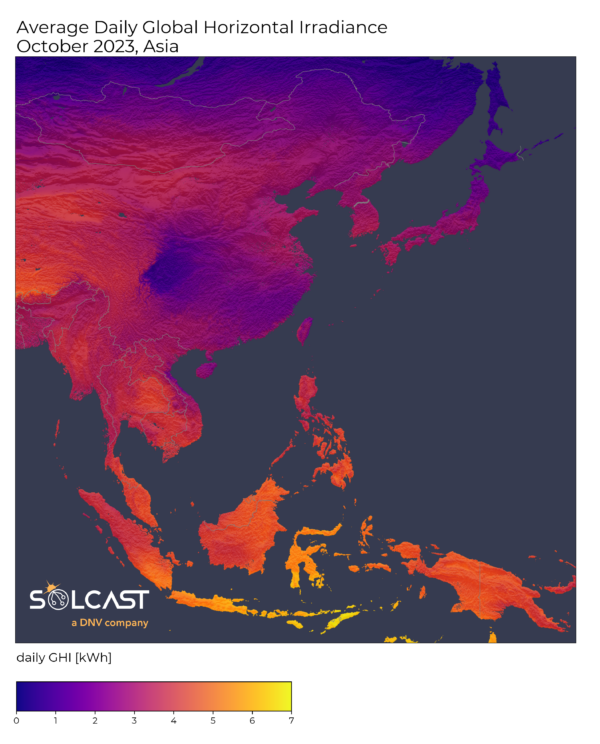Solar assets across most of Asia benefited from increased irradiance through October. This was due to blocking high-pressure systems that kept low-pressure systems further north and reduced cloud formation, according to analysis collected by Solcast API. India saw drier conditions – something cricket fans would appreciate for the October to November Cricket World Cup.
Otherwise sunny conditions were tempered by an early October typhoon making landfall in Taiwan and eastern mainland China. A large high-pressure system hovered over Asia and concentrated over western China, which dampened normal cloud formation patterns. This caused above-long-term October average irradiance levels for almost the entire continent. Regions with increased irradiance, as seen below, include the east coast of Japan and the western Yangtze Basin in China, which received over 130% of normal irradiance for the month.

Typhoon Koinu was strengthened by warm sea surface temperatures and the weather system impacted Taiwan and eastern mainland China in early October. The Typhoon smashed through the blocking high pressure and the resultant cloud brought down the irradiance for October to 80-90% of the long-term average.
The Northern Hemisphere winter is becoming evident when looking at actual total irradiance rather than the deviation from the average. The difference in irradiance totals between the mid-latitudes and the tropics is much starker than several months ago.

Solcast produces these figures by tracking clouds and aerosols at 1-kilometer and 2-kilometer resolution globally, using satellite data and proprietary AI/ML algorithms. This data is used to drive irradiance models, enabling Solcast to calculate irradiance at high resolution, with a typical bias of less than 2%, and also cloud-tracking forecasts. This data is used by more than 300 companies managing over 150 GW of solar assets globally.
The views and opinions expressed in this article are the author’s own, and do not necessarily reflect those held by pv magazine.
This content is protected by copyright and may not be reused. If you want to cooperate with us and would like to reuse some of our content, please contact: editors@pv-magazine.com.



By submitting this form you agree to pv magazine using your data for the purposes of publishing your comment.
Your personal data will only be disclosed or otherwise transmitted to third parties for the purposes of spam filtering or if this is necessary for technical maintenance of the website. Any other transfer to third parties will not take place unless this is justified on the basis of applicable data protection regulations or if pv magazine is legally obliged to do so.
You may revoke this consent at any time with effect for the future, in which case your personal data will be deleted immediately. Otherwise, your data will be deleted if pv magazine has processed your request or the purpose of data storage is fulfilled.
Further information on data privacy can be found in our Data Protection Policy.